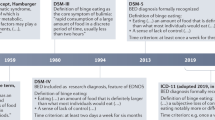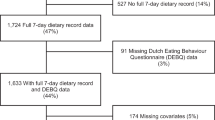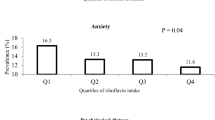Abstract
Background:
The psychological symptoms associated with binge eating disorder (BED) have been well documented. However, the physical symptoms associated with BED have not been explored. Gastrointestinal (GI) symptoms such as heartburn and diarrhea are more prevalent in obese adults, but the associations remain unexplained. Patients with bulimia have increased gastric capacity. The objective of the study was to examine if the severity of binge eating episodes would be associated with upper and lower GI symptoms.
Methods:
Population-based survey of community residents through a mailed questionnaire measuring GI symptoms, frequency of binge eating episodes and physical activity level. The association of GI symptoms with frequency of binge eating episodes was assessed using logistic regression models adjusting for age, gender, body mass index (BMI) and physical activity level.
Results:
In 4096 subjects, BED was present in 6.1%. After adjusting for BMI, age, gender, race, diabetes mellitus, socioeconomic status and physical activity level, BED was independently associated with the following upper GI symptoms: acid regurgitation (P<0.001), heartburn (P<0.001), dysphagia (P<0.001), bloating (P<0.001) and upper abdominal pain (P<0.001). BED was also associated with the following lower GI symptoms: diarrhea (P<0.001), urgency (P<0.001), constipation (P<0.01) and feeling of anal blockage (P=0.001).
Conclusion:
BED appears to be associated with the experience of both upper and lower GI symptoms in the general population, independent of the level of obesity. The relationship between increased GI symptoms and physiological responses to increased volume and calorie loads, nutritional selections and rapidity of food ingestion in individuals with BED deserves further study.
This is a preview of subscription content, access via your institution
Access options
Subscribe to this journal
Receive 12 print issues and online access
$259.00 per year
only $21.58 per issue
Buy this article
- Purchase on Springer Link
- Instant access to full article PDF
Prices may be subject to local taxes which are calculated during checkout



Similar content being viewed by others
References
Horwitz BJ, Fisher RS . Current concepts: the irritable bowel syndrome. N Engl J Med 2001; 344: 1846–1850.
Delgado-Aros S, Locke III GR, Camilleri MC, Talley NJ, Fett SL, Zinsmeister AR et al. Obesity is associated with increased risk of gastrointestinal symptoms: a population-based study. Am J Gastroenterol 2004; 99: 1801–1806.
Crowell MD, Cheskin LJ, Musial F . Prevalence of gastrointestinal symptoms in obese and normal weight binge eaters. Am J Gastroenterol 1994; 89: 387–391.
Flegal KM, Carroll MD, Ogden CL, Johnson CL . Prevalence and trends in obesity among US adults, 1999–2000. JAMA 2002; 288: 1723–1727.
Nilsson M, Johnsen R, Ye W, Hveem K, Lagergren J . Obesity and estrogen as risk factors for gastroesophageal reflux symptoms. JAMA 2003; 290: 66–72.
Nilsson M, Lundegardh G, Carling L, Ye W, Lagegren J . Body mass and reflux oesophagitis: an oestrogen-dependent association? Scand J Gastroenterol 2002; 37: 626–630.
Cremonini F, Locke GRI, Schleck CD, Zinsmeister AR, Talley NJ . The relationship between upper gastrointestinal symptoms and changes in body weight in a population-based cohort. Neurogastro Motil 2006; 18: 987–994.
Hay P, Fairburn C . The validity of the DSM-IV scheme for classifying bulimic eating disorders. Int J Eat Disord 1998; 23: 7–15.
Fairburn CG, Cooper Z, Doll HA, Norman P, O’Connor M . The natural course of bulimia nervosa and binge eating disorder in young women. Arch Gen Psychiatry 2000; 57: 659–665.
Loro ADJ, Orleans CS . Binge eating in obesity: preliminary findings and guidelines for behavioral analysis and treatment. Addict Behav 1981; 6: 155–166.
Gormally J, Black S, Daston S, Rardin D . The assessment of binge eating severity among obese persons. Addict Behav 1982; 7: 47–55.
Marcus MD, Wing RR, Lamparski DM . Binge eating and dietary restraint in obese patients. Addict Behav 1985; 10: 163–168.
Linde JA, Jeffery RW, Levy RL, Sherwood NE, Utter J, Pronk NP et al. Binge eating disorder, weight control self-efficacy, and depression in overweight men and women. Int J Obes Relat Metab Disord 2004; 28: 418–425.
Rieger E, Wilfley DE, Stein RI, Marion V, Crow SJ . A comparison of quality of life in obese individuals with and without binge eating disorder. Int J Eat Disord 2005; 37: 234–240.
Cargill BR, Clark MM, Pera V, Niaura RS, Abrams DB . Binge eating, body image, depression and self-efficacy in an obese clinical population. Obes Res 1999; 7: 379–386.
Wolff GE, Clark MM . Changes in eating self-efficacy and body image following cognitive-behavioral group therapy for binge eating disorder: a clinical study. Eat Behav 2001; 2: 97–104.
Pasricha PJ . Desperately seeking serotonin. A commentary on the withdrawal of tegaserod and the state of drug development for functional and motility disorders. Gastroenterology 2007; 132: 2287–2290.
Geliebter A, Hashim SA . Gastric capacity in normal, obese, and bulimic women. Physiol Behav 2001; 74: 743–746. Erratum in: Physiol Behav 2002;75:433.
Geliebter A, Yahav EK, Gluck ME, Hashim SA . Gastric capacity, test meal intake, and appetitive hormones in binge eating disorder. Physiol Behav 2004; 81: 735–740.
Geliebter A . Stomach capacity in obese individuals. Obes Res 2001; 9: 727–728.
Kim DY, Camilleri M, Murray JA, Stephens DA, Levine JA, Burton DD . Is there a role for gastric accommodation and satiety in asymptomatic obese people? Obes Res 2001; 9: 655–661.
Vazquez Roque MI, Camilleri M, Stephens DA, Jensen MD, Burton DD, Baxter KL et al. Gastric sensorimotor functions and hormone profile in normal weight, overweight and obese people. Gastroenterology 2006; 131: 1717–1724.
Delgado-Aros S, Camilleri M, Castillo EJ, Cremonini F, Stephens D, Ferber I et al. Effect of gastric volume or emptying on meal-related symptoms after liquid nutrients in obesity: a pharmacologic study. Clin Gastroenterol Hepatol 2005; 131: 1717–1724.
Bi L, Triadafilopoulos G . Exercise and gastrointestinal function and disease: an evidence-based review of risks and benefits. Clin Gastroenterol Hepatol 2003; 1: 345–355.
Melton III LJ . History of the Rochester epidemiology project. Mayo Clin Proc 1996; 71: 266–274.
Kurland LT, Brian DD . Contributions to neurology from records linkage in Olmsted County, Minnesota. Adv Neurol 1978; 19: 93–105.
Talley N, Phillips S, Wiltgen C, Zinsmeister A, Melton LJ . Assessment of functional gastrointestinal disease: the bowel disease questionnaire. Mayo Clin Proc 1990; 65: 1456–1479.
Moore DB, Folsom AR, Mink PJ, Hong CP, Anderson KE, Kushi LH . Physical activity and incidence of postmenopausal breast cancer. Epidemiology 2000; 11: 292–296.
Kuczmarski MF, Kuczmarski RJ, Najjar M . Effects of age on validity of self-reported height, weight, and body mass index: findings from the Third National Health and Nutrition Examination Survey, 1988–1994. J Am Diet Assoc 2001; 101: 28–34; quiz 35–6.
World Health Organization. Obesity: Preventing and Managing the Global Epidemic. Report of a WHO consultation on obesity Geneva, 1997.
Ware JJ, Kosinski M, Keller SD . A 12-Item Short-Form Health Survey: construction of scales and preliminary tests of reliability and validity. Med Care 1996; 34: 220–233.
Delgado-Aros S, Cremonini F, Castillo JE, Chial HJ, Burton DD, Ferber I et al. Independent influences of body mass and gastric volumes on satiation in humans. Gastroenterology 2004; 126: 432–440.
Tack J, Piessevaux H, Coulie B, Caenepeel P, Janssens J . Role of impaired gastric accommodation to a meal in functional dyspepsia. Gastroenterology 1998; 115: 1346–1352.
Tack J, Caenepeel P, Corsetti M, Janssens J . Role of tension receptors in dyspeptic patients with hypersensitivity to gastric distention. Gastroenterology 2004; 127: 1058–1066.
Delgado-Aros S, Camilleri M, Cremonini F, Ferber I, Stephens D, Burton DD . Contributions of gastric volumes and gastric emptying to meal size and postmeal symptoms in functional dyspepsia. Gastroenterology 2004; 127: 1685–1694.
Wildi SM, Tutuian R, Castell DO . The influence of rapid food intake on postprandial reflux: studies in healthy volunteers. Am J Gastroenterol 2004; 99: 1645–1651.
Esfandyari T, Potter JW, Vaezi MF . Dysphagia: a cost analysis of the diagnostic approach. Am J Gastroenterol 2002; 97: 2733–2737.
Kellow JE, Phillips SF, Miller LJ, Zinsmeister AR . Dysmotility of the small intestine in irritable bowel syndrome. Gut 1988; 29: 1236–1243.
Simren M, Abrahamsson H, Bjornsson ES . An exaggerated sensory component of the gastrocolonic response in patients with irritable bowel syndrome. Gut 2001; 48: 20–27.
Nehra V, Bruce BK, Rath-Harvey DM, Pemberton JH, Camilleri M . Psychological disorders in patients with evacuation disorders and constipation in a tertiary practice. Am J Gastroenterol 2000; 95: 1755–1758.
Delgado-Aros S, Busciglio I, Andreu Garcia M, Burton D, Camilleri M . Body mass influence on colonic sensory-motor function and gastrointestinal transit: a study of 165 healthy participants. Gastroenterology 2007; 132: A-456.
Yanovski SA, Lett M, Yanovski JA, Flood M, Gold PW, Kissileff HR et al. Food selection and intake of obese women with binge-eating disorder. Am J Clin Nutr 1992; 56: 975–980.
Raymond NC, Neumeyer B, Warren CS, Lee SS, Peterson CB . Energy intake patterns in obese women with binge eating disorder. Obes Res 2003; 11: 869–879.
Dymek-Valentine M, Rienecke-Hoste R, Alverdy J . Assessment of binge eating disorder in morbidly obese patients evaluated for gastric bypass: SCID versus QEWP-R. Eat Weight Disord 2004; 9: 211–216.
Vamado PJ, Williamson DA, Bentz BG, Ryan DH, Rhodes SK, O’Neil PM et al. Prevalence of binge eating disorder in obese adults seeking weight loss treatment. Eat Weight Disord 1997; 2: 117–124.
Celio AA, Wilfley DE, Crow SJ, Mitchell J, Walsh BT . A comparison of the binge eating scale, questionnaire for eating and weight patterns-revised, and eating disorder examination questionnaire with instructions with the eating disorder examination in the assessment of binge eating disorder and its symptoms. Int J Eat Disord 2004; 36: 434–444.
Flood V, Webb K, Lazarus R, Pang G . Use of self-report to monitor overweight and obesity in populations: some issues for consideration. Aust NZ Public Health 2000; 24: 96–99.
Paccaud F, Wiestlisbach V, Rickenbach M . Body mass index: comparing mean values and prevalence rates from telephone and examination surveys. Rev Epidemiol Sante Publique 2001; 49: 33–40.
Acknowledgements
Dr Camilleri and Dr Talley received support by Grant DK67071 from the National Institutes of Health for this study.
Author information
Authors and Affiliations
Corresponding author
Rights and permissions
About this article
Cite this article
Cremonini, F., Camilleri, M., Clark, M. et al. Associations among binge eating behavior patterns and gastrointestinal symptoms: a population-based study. Int J Obes 33, 342–353 (2009). https://doi.org/10.1038/ijo.2008.272
Received:
Revised:
Accepted:
Published:
Issue Date:
DOI: https://doi.org/10.1038/ijo.2008.272
Keywords
This article is cited by
-
Association of participants who screened positive for night eating syndrome with physical health, sleep problems, and weight status in an Australian adult population
Eating and Weight Disorders - Studies on Anorexia, Bulimia and Obesity (2023)
-
Binge-eating and sodium bicarbonate: a potent combination for gastric rupture in adults—two case reports and a review of literature
Journal of Eating Disorders (2022)
-
Binge eating disorder
Nature Reviews Disease Primers (2022)
-
Psychopathological aspects of dysphagia: a systematic review on correlations with eating disorders and other psychiatric conditions
Eating and Weight Disorders - Studies on Anorexia, Bulimia and Obesity (2022)
-
Gastrointestinal Interoception in Eating Disorders: Charting a New Path
Current Psychiatry Reports (2022)



